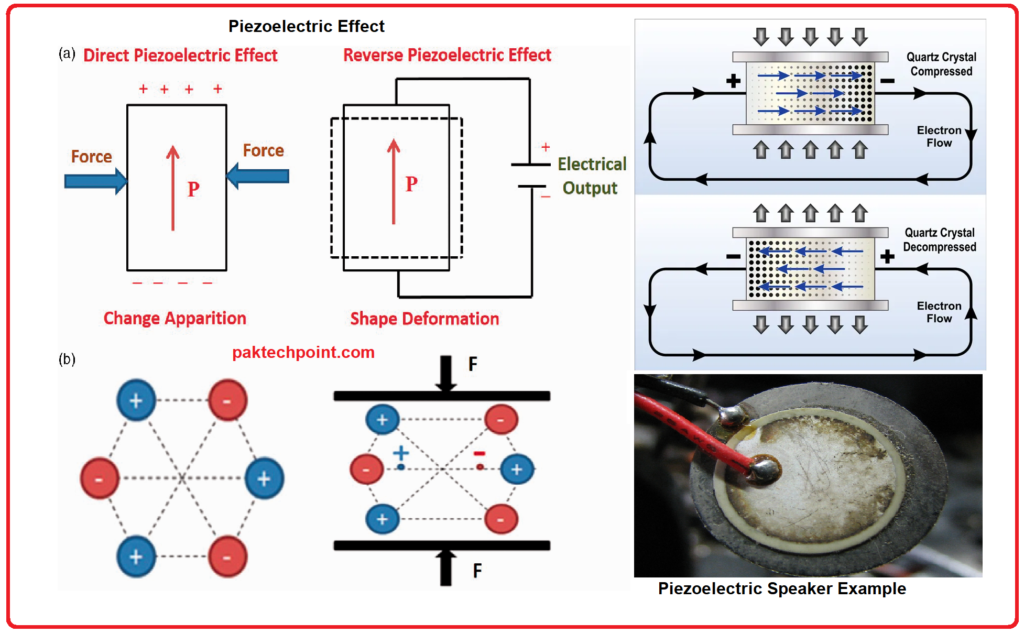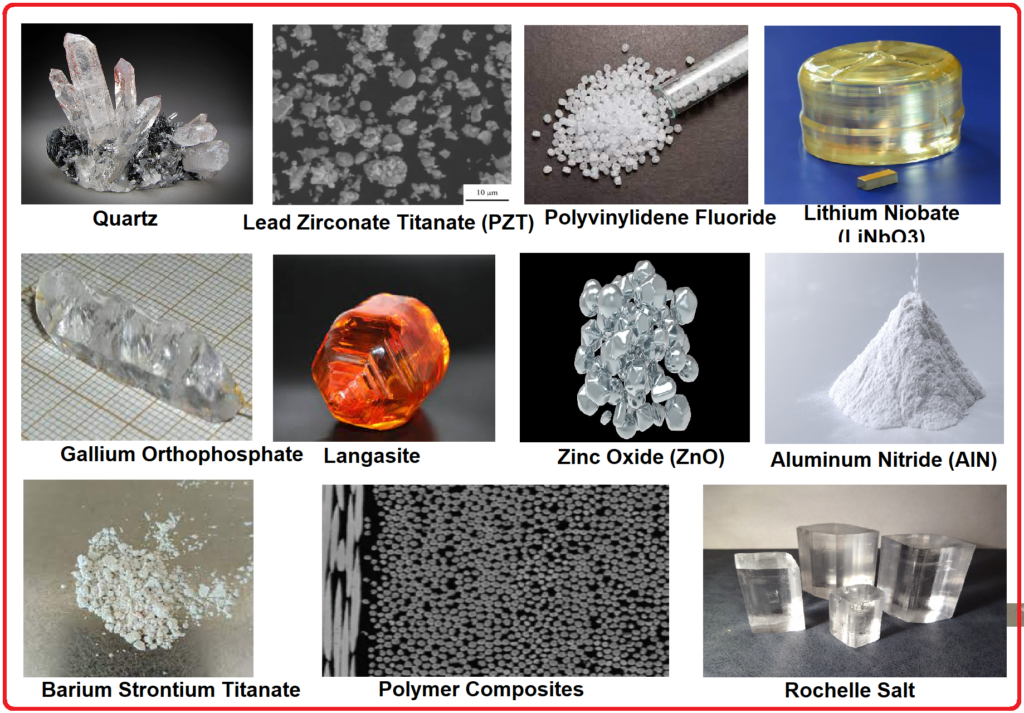Piezoelectricity is a unique and intriguing property exhibited by certain materials that allows them to generate an electric charge in response to mechanical stress or pressure, and vice versa. In simple terms, it’s the ability of certain crystals and materials to convert mechanical energy into electrical energy, and electrical energy into mechanical energy. This phenomenon forms the basis of various technological applications across different industries.
Pierre and Jacques Curie’s Discovery of Piezoelectricity
Piezoelectricity was first discovered by the French physicists Pierre Curie and Jacques Curie in the late 19th century. The Curie brothers conducted extensive research on the electrical properties of crystals and made significant contributions to the understanding of piezoelectric phenomena.

In 1880, Pierre Curie and his brother Jacques Curie observed that certain crystals, particularly quartz, exhibited a phenomenon in which mechanical stress or pressure caused the generation of electric charge on the crystal’s surface. This observation marked the discovery of the direct piezoelectric effect—the conversion of mechanical energy into electrical energy.
Pierre and Jacques Curie’s groundbreaking work laid the foundation for the study of piezoelectricity and opened up new avenues for research into the electrical properties of materials. Their pioneering contributions not only led to the identification of the piezoelectric effect but also initiated the exploration of its various applications in science, technology, and engineering.
What is Piezoelectricity?
The word “piezoelectric” is derived from the Greek words “piezo” meaning “to squeeze” or “press,” and “electric,” indicating the generation of electric charge. This property was first discovered in the mid-19th century by French physicists Pierre and Jacques Curie while studying crystals like quartz and tourmaline.

Key points about piezoelectricity:
- Crystal Structure: Piezoelectricity is most commonly observed in crystals with non-centrosymmetric (lack of symmetry about a central point) crystal structures. These crystals have atoms arranged in such a way that the positive and negative charges are not perfectly balanced, leading to the generation of an electric field when the crystal is deformed.
- Direct Piezoelectric Effect: When mechanical stress or pressure is applied to a piezoelectric material, it causes a distortion in the crystal lattice, leading to the separation of positive and negative charges. This charge separation results in the generation of an electric voltage or potential difference across the material.
- Inverse Piezoelectric Effect: The inverse piezoelectric effect, also known as the electrostrictive effect, is the reverse process. When an electric field is applied to a piezoelectric material, it causes a change in its shape or deformation. This property is widely used in applications like piezoelectric actuators.
- Applications: Piezoelectric materials and devices are used in a wide range of applications. They are essential components in sensors, transducers, actuators, and energy harvesting devices. For example, piezoelectric transducers are used in ultrasound technology for medical imaging, while piezoelectric actuators are employed in precise positioning systems.
- Energy Harvesting: Piezoelectric materials can also be used to convert ambient mechanical vibrations into electrical energy. This concept is used in various energy harvesting technologies, where vibrations from sources like footsteps or machinery are transformed into usable electrical power.
- Diverse Industries: Piezoelectricity finds applications in industries such as healthcare, aerospace, automotive, consumer electronics, energy, and more. Its ability to convert between different forms of energy makes it a valuable tool in modern technology.
In essence, piezoelectricity is a remarkable phenomenon that highlights the interconnectedness of mechanical and electrical properties in certain materials. Its discovery and continued exploration have led to significant advancements in various fields, contributing to the development of innovative devices and technologies that shape our modern world.
Piezoelectricity Working Principle
Piezoelectricity is a remarkable phenomenon rooted in the unique atomic arrangement of certain crystals. Let’s explain into how it works using a simplified animation:
Imagine you have a piezoelectric crystal. Normally, the charges within the crystal are arranged in such a way that they exactly balance each other out. This means that even if the arrangement of charges isn’t symmetrical, their effects cancel each other, resulting in no net charge on the crystal’s surfaces.

However, when you apply mechanical pressure to the crystal, something extraordinary happens. This pressure causes the crystal’s atoms to shift slightly from their original positions. While this movement is relatively small on the atomic scale, its impact is significant.

As the crystal is squeezed (keep in mind that this exaggeration is for visualization purposes), the balanced arrangement of charges is disrupted. The pressure forces some of the charges to move out of their equilibrium positions. This shift in charge distribution creates an imbalance of positive and negative charges within the crystal.

Here’s where the magic of piezoelectricity comes into play: The effects of these shifted charges no longer cancel each other out. Instead, net positive charges accumulate on one face of the crystal, while net negative charges accumulate on the opposite face.
The result? A voltage—a difference in electric potential—across the two faces of the crystal. This voltage is a direct consequence of the piezoelectric effect. By simply squeezing the crystal, you’ve generated an electric charge separation that creates an electric field within the material.

This electric field has practical applications. It can be harnessed to produce electrical energy when the crystal is subjected to mechanical stress or pressure. Conversely, by applying an electric field across the crystal, you can induce mechanical deformation—a phenomenon known as the inverse piezoelectric effect.
In essence, the animation simplifies the process, but it captures the fundamental principle of piezoelectricity: the conversion of mechanical energy into electrical energy due to changes in the arrangement of charges within a crystal lattice. This phenomenon has far-reaching implications, powering devices, sensors, and technologies that have revolutionized multiple industries.
Piezoelectric Materials
There are several materials that exhibit piezoelectric properties, either naturally occurring or synthetically developed. Here are some notable piezoelectric materials:

- Quartz: Quartz is one of the most well-known naturally occurring piezoelectric materials. It is often used in various electronic devices, including oscillators, filters, and sensors.
- Lead Zirconate Titanate (PZT): PZT is a widely used synthetic piezoelectric material due to its high piezoelectric coefficients and versatility. It is used in sensors, actuators, transducers, and more.
- Piezoelectric Ceramics: Apart from PZT, various other ceramics such as barium titanate (BaTiO3) and lead magnesium niobate-lead titanate (PMN-PT) ceramics exhibit piezoelectric properties.
- Polyvinylidene Fluoride (PVDF): PVDF is a piezoelectric polymer that is flexible and lightweight. It finds applications in sensors, energy harvesting, and wearable devices.
- Lithium Niobate (LiNbO3): Lithium niobate is often used in surface acoustic wave (SAW) devices and optical applications due to its piezoelectric and electro-optic properties.
- Gallium Orthophosphate (GaPO4): Gallium orthophosphate is used in high-temperature applications where other piezoelectric materials may not be suitable.
- Langasite: Langasite crystals have high-temperature stability and are used in high-temperature sensing and actuation applications.
- Zinc Oxide (ZnO): ZnO is a versatile material used in various forms, including thin films and nanostructures, for piezoelectric devices and sensors.
- Aluminum Nitride (AlN): Aluminum nitride is used in acoustic wave devices, sensors, and actuators due to its excellent thermal stability and piezoelectric properties.
- Barium Strontium Titanate (BST): BST is a ferroelectric material that exhibits both piezoelectric and dielectric properties, making it useful in sensors and energy storage applications.
- Polymer Composites: Various polymer composites, such as piezoelectric fibers embedded in a polymer matrix, are being developed for flexible and wearable electronics.
- Rochelle Salt: Rochelle salt (potassium sodium tartrate) is a naturally occurring piezoelectric material that was historically used in early demonstrations of the piezoelectric effect.
These are just a few examples of piezoelectric materials with varying properties and applications. Researchers continue to explore new materials and improve existing ones to enhance the efficiency and versatility of piezoelectric devices and technologies.
Causes of Piezoelectricity:
Piezoelectricity is a fascinating phenomenon rooted in the intricate atomic arrangement of certain crystals. To understand the underlying cause of piezoelectricity, we need to explore the crystal structure and the behavior of atoms within these materials.
When we think of a crystal, we might imagine a pattern of atoms connected by bonds, resembling a climbing frame. However, the scientific definition of a crystal goes beyond the common perception of shiny gemstones. In scientific terms, a crystal refers to any solid material with an ordered atomic arrangement based on repeating unit cells. This unit cell is akin to a fundamental building block that is repeated throughout the crystal lattice.
In most crystals, including metals, the unit cell exhibits symmetry. However, piezoelectric crystals break away from this norm. While the atomic arrangement may not be symmetric, the charges within the crystal are balanced, resulting in overall electrical neutrality. This balance of positive and negative charges creates an equilibrium state where the presence of a positive charge in one region is counteracted by a corresponding negative charge nearby.
The magic of piezoelectricity comes into play when mechanical stress is applied to these unique crystals. When you compress or stretch a piezoelectric crystal, you alter its structure. This deformation affects the spacing between atoms, leading to changes in the balance of charges. The result is the emergence of net electrical charges on opposite faces of the crystal. In simple terms, mechanical stress disrupts the charge balance, generating electric polarization.
This piezoelectric effect is not limited to a localized region within the crystal; it spreads throughout the entire structure. As a consequence, positive and negative charges accumulate on opposite outer surfaces of the crystal, creating an electric potential across the material.
The intriguing aspect of piezoelectricity is that it works both ways. Applying an electric field across a piezoelectric crystal initiates a phenomenon known as the inverse piezoelectric effect. In this case, the electric field exerts a force on the atoms within the crystal, prompting them to readjust and rebalance the charge distribution. This atomic movement, in turn, leads to a change in the crystal’s shape—deformation occurs. This reciprocal relationship between electrical and mechanical responses underscores the essence of the piezoelectric effect.
In essence, piezoelectricity arises from the disruption of charge balance caused by mechanical stress. The ability of certain crystals to undergo this transformation opens the door to a myriad of applications, ranging from medical imaging and energy harvesting to sensors and actuators. As our understanding of the piezoelectric effect deepens, its potential to reshape various technological landscapes becomes even more apparent.
Unleashing Potential: Energy Harvesting with Piezoelectricity
In a world constantly seeking innovative ways to harness energy, the concept of energy harvesting with piezoelectricity has ignited curiosity and sparked imagination. The idea of converting mechanical motion into usable electricity through the magic of piezoelectric crystals has led to intriguing possibilities, from powering gadgets with body movements to illuminating streets with passing vehicles. However, while energy harvesting presents opportunities, it’s important to scrutinize its feasibility and impact in the broader context of energy conservation and efficiency.
The fundamental principle behind energy harvesting with piezoelectricity is captivatingly simple. Just as a single press on a piezoelectric crystal generates a small amount of electricity, envision pressing multiple crystals repeatedly to accumulate significant energy. This vision has led to imaginative proposals, including embedding crystals beneath city streets and pavements to capture the energy generated by the movement of cars and pedestrians. The idea is to tap into otherwise wasted energy and convert it into a usable form.

Yet, as with any technological concept, a critical analysis is essential. Energy harvesting schemes, while intriguing, can sometimes divert attention from more effective solutions. Take the example of piezoelectric “rumble strips” on roads, designed to capture energy from passing vehicles. While this approach might seem efficient, the energy potential recoverable from vehicles is limited, given the inefficiency of traditional combustion engines. Investing in more fuel-efficient engines, transitioning to electric vehicles, or promoting carpooling could yield more substantial energy savings than piezoelectric road systems.
Energy harvesting undoubtedly has its place, particularly in scenarios where small amounts of otherwise wasted energy can be captured. Consider the case of wearable devices that convert body movements into power for charging. Imagine a world where your cellphone replenishes its battery every time you move—a practical application that maximizes convenience.
However, the crux of the matter lies in balance. When discussing energy conservation, a holistic approach is crucial. While piezoelectric energy harvesting may provide localized gains, the broader impact of energy inefficiencies should not be overshadowed. The potential benefits must be weighed against the overall investment of time and resources. For instance, allocating funds to enhance the efficiency of energy-intensive processes or transition to cleaner energy sources could yield more substantial and sustainable outcomes.
In essence, energy harvesting with piezoelectricity is a captivating concept that taps into the creative potential of technology. It showcases the adaptability of piezoelectric materials to transform otherwise overlooked energy into usable power. However, as we journey toward a more energy-efficient future, it’s vital to maintain a perspective that considers the larger energy landscape. By carefully evaluating the benefits and costs, we can ensure that our efforts align with the overarching goal of minimizing energy waste and optimizing efficiency.
Empowering Technology: The Versatility of Piezoelectric Transducers
In modern technology, the need to convert one form of energy into another arises in various scenarios. From ultrasound equipment to microphones and even spark lighters, the role of piezoelectric transducers becomes indispensable. These devices seamlessly bridge the gap between mechanical and electrical domains, enabling us to harness energy for diverse applications.
At its core, a piezoelectric transducer is a remarkable instrument designed to transform minute amounts of energy from one type to another. Be it converting mechanical pressure into electrical signals or vice versa, the versatility of piezoelectric transducers finds its way into an array of technological advancements.
Consider the realm of medical imaging where ultrasound equipment reigns supreme. Piezoelectric transducers within these devices play a vital role in converting electrical energy into rapid mechanical vibrations. These vibrations occur at frequencies too high-pitched for human ears to perceive but serve essential functions such as scanning and cleaning. The ability of these transducers to facilitate precise and rapid energy conversion revolutionizes the field of medical diagnostics and procedures.
In the realm of audio technology, the prowess of piezoelectric crystals is equally evident. Microphones, tasked with converting sound energy into electrical signals, employ piezoelectric crystals to achieve this feat. As sound waves reach the crystal, they induce mechanical vibrations, generating corresponding electrical signals. Similarly, the reverse process occurs in record players (gramophones), where piezoelectric crystals capture vibrations from a stylus traversing a vinyl groove, thereby converting mechanical movement into electrical signals.
The world of timekeeping benefits from the precision of piezoelectricity. Quartz clocks and watches utilize the reverse-piezoelectric effect to maintain accurate timekeeping. An oscillating piezoelectric crystal, driven by electrical energy, forms the heart of these timepieces. Its rapid oscillations are translated into precise timekeeping intervals through electronic circuits, intricate gears, and motors.
Even everyday gadgets incorporate piezoelectricity in subtle yet impactful ways. Spark lighters for gas stoves and barbecues employ piezoelectric crystals to generate sparks through mechanical pressure. Inkjet printers employ electronically controlled piezoelectric crystals to drive precision syringes for depositing ink droplets onto paper.
Piezoelectric transducers, with their ability to seamlessly convert energy between mechanical and electrical forms, underscore the synergy between scientific principles and practical applications. These devices epitomize the convergence of innovation and convenience, enabling technological marvels that shape our contemporary world. From medical diagnostics to audio experiences and beyond, piezoelectric transducers continue to be the unsung heroes driving progress in numerous fields.
Read Also: PIEZO ELECTRIC EFFECT AND APPLICATION